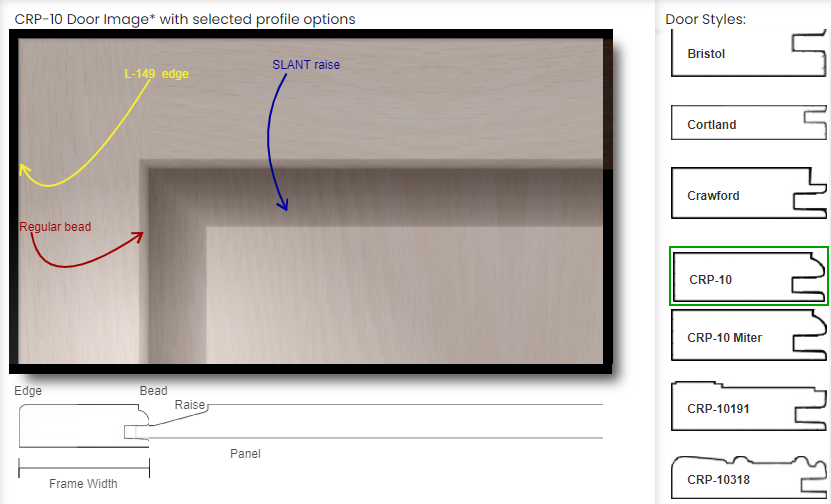Categories:

As I mentioned in my previous article, deciding on the right Conestoga cabinet door style for your project is arguably the most important part of the design process—after all, the doors make up most of what’s visible of kitchen or vanity cabinets. At The Cabinet Authority, we wanted to make sure that our customers would be able to design their doors with as many resources as possible, so we created the Profile Options Tool. This lets you pick out all the details of your door and have them shown to you in real time. Unique in the industry, this tool is one of the most helpful ways to narrow down your cabinet door options.
While we have an excellent glossary for many of the terms we use, it’s worth highlighting the ones specifically related to door profiles:
Door Style
Essentially the foundation for any other cabinet door design choices, the door style determines the framing width and panel depth of the door. Some also include decorative routing or other details. Something to keep an eye on here is whether you wanted mitered or mortise-and-tenon joints on your doors. Mitered joints mean the corners of the door are joined at 45 degree angles, much like many picture frames, whereas mortise-and-tenon joints mean the top and sides are joined at 90 degree angles. While mortise-and-tenon joints are a bit stronger, both are plenty durable for cabinet doors. For more ornate door styles with decorative routing or moulding, miter joints allow for a more seamless corner in the design.
Edges
The edge profile of the door is more or less what it sounds like—the detail around the outer edge of the door. Our most common choices here are simple roundovers like the L-149 or L-1160 or the square Machine Edge. Of course there are dozens of other options to help you be able to match existing cabinetry or even if you just want a little more detail to your doors. Please note that many of these options besides the ones listed previously are not available with inset doors.
Framing Bead
Often the most-overlooked detail in a door, the framing bead is essentially the opposite of the edge profile: it refers to the detailing where the interior of the frame meets the door panel. Many framing beads are automatically determined based on the door style you choose, but for some doors like the TW-10 or CRP-10 it’s an important choice. They range from the simple, Shaker-style “Square” bead all the way to ornate options like the Elite bead.
Panel Raise
Depending on the look you’re going for, the panel raise can make a substantial difference in the appearance of your door, from simple and robust to delicate and sophisticated. While Shaker doors are defined by having flat panels (the P-057 raise, in most cases), many raised-panel cabinet doors have a lot of flexibility. Note that small doors or drawer fronts (below 7” or so in either dimension) may limit some panel raises .
Our profile options picker lets you play with all these options and develop the perfect Conestoga cabinet door for your kitchen, vanity, or home office. It’s always our goal to have the best-informed customers on the market, and this is one of several ways in which we hope to let our customers make the right design choices for their projects.